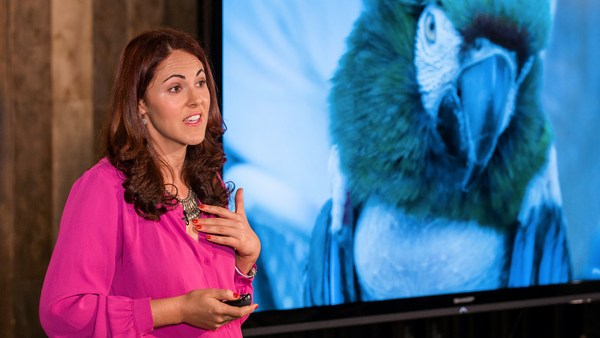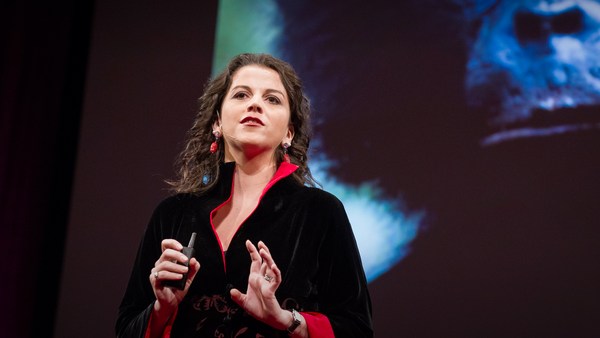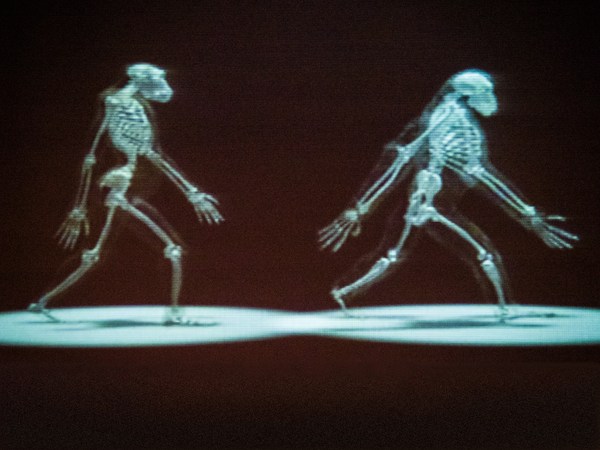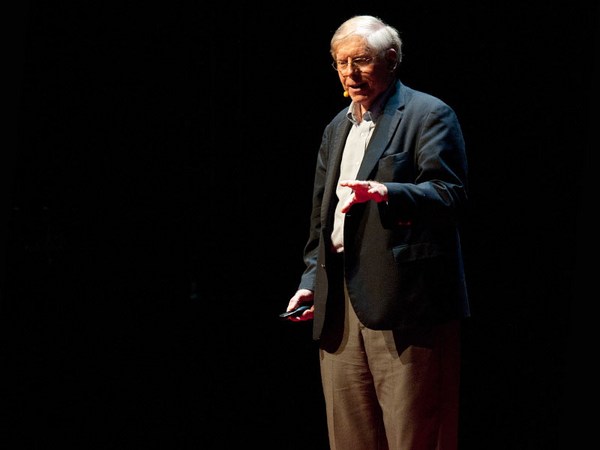Ten years ago, I got a phone call that changed my life. At the time, I was cardiologist at UCLA, specializing in cardiac imaging techniques. The call came from a veterinarian at the Los Angeles Zoo. An elderly female chimpanzee had woken up with a facial droop and the veterinarians were worried that she'd had a stroke. They asked if I'd come to the zoo and image the animal's heart to look for a possible cardiac cause.
Now, to be clear, North American zoos are staffed by highly qualified, board-certified veterinarians who take outstanding care of their animal patients. But occasionally, they do reach into the human medical community, particularly for some speciality consultation, and I was one of the lucky physicians who was invited in to help. I had a chance to rule out a stroke in this chimpanzee and make sure that this gorilla didn't have a torn aorta, evaluate this macaw for a heart murmur, make sure that this California sea lion's paricardium wasn't inflamed, and in this picture, I'm listening to the heart of a lion after a lifesaving, collaborative procedure with veterinarians and physicians where we drained 700 cc's of fluid from the sac in which this lion's heart was contained. And this procedure, which I have done on many human patients, was identical, with the exception of that paw and that tail.
Now most of the time, I was working at UCLA Medical Center with physicians, discussing symptoms and diagnoses and treatments for my human patients, but some of the time, I was working at the Los Angeles Zoo with veterinarians, discussing symptoms and diagnoses and treatments for their animal patients. And occasionally, on the very same day, I went on rounds at UCLA Medical Center and at the Los Angeles Zoo. And here's what started coming into very clear focus for me. Physicians and veterinarians were essentially taking care of the same disorders in their animal and human patients: congestive heart failure, brain tumors, leukemia, diabetes, arthritis, ALS, breast cancer, even psychiatric syndromes like depression, anxiety, compulsions, eating disorders and self-injury.
Now, I've got a confession to make. Even though I studied comparative physiology and evolutionary biology as an undergrad -- I had even written my senior thesis on Darwinian theory -- learning about the significant overlap between the disorders of animals and humans, it came as a much needed wake-up call for me. So I started wondering, with all of these overlaps, how was it that I had never thought to ask a veterinarian, or consult the veterinary literature, for insights into one of my human patients? Why had I never, nor had any of my physician friends and colleagues whom I asked, ever attended a veterinary conference? For that matter, why was any of this a surprise? I mean, look, every single physician accepts some biological connection between animals and humans. Every medication that we prescribe or that we've taken ourselves or we've given to our families has first been tested on an animal.
But there's something very different about giving an animal a medication or a human disease and the animal developing congestive heart failure or diabetes or breast cancer on their own. Now, maybe some of the surprise comes from the increasing separation in our world between the urban and the nonurban. You know, we hear about these city kids who think that wool grows on trees or that cheese comes from a plant. Well, today's human hospitals, increasingly, are turning into these gleaming cathedrals of technology. And this creates a psychological distance between the human patients who are being treated there and animal patients who are living in oceans and farms and jungles.
But I think there's an even deeper reason. Physicians and scientists, we accept intellectually that our species, Homo sapiens, is merely one species, no more unique or special than any other. But in our hearts, we don't completely believe that. I feel it myself when I'm listening to Mozart or looking at pictures of the Mars Rover on my MacBook. I feel that tug of human exceptionalism, even as I recognize the scientifically isolating cost of seeing ourselves as a superior species, apart. Well, I'm trying these days. When I see a human patient now, I always ask, what do the animal doctors know about this problem that I don't know? And, might I be taking better care of my human patient if I saw them as a human animal patient?
Here are a few examples of the kind of exciting connections that this kind of thinking has led me to. Fear-induced heart failure. Around the year 2000, human cardiologists "discovered" emotionally induced heart failure. It was described in a gambling father who had lost his life's savings with a roll of the dice, in a bride who'd been left at the alter. But it turns out, this "new" human diagnosis was neither new, nor was it uniquely human. Veterinarians had been diagnosing, treating and even preventing emotionally induced symptoms in animals ranging from monkeys to flamingos, from to deer to rabbits, since the 1970s. How many human lives might have been saved if this veterinary knowledge had been put into the hands of E.R. docs and cardiologists?
Self-injury. Some human patients harm themselves. Some pluck out patches of hair, others actually cut themselves. Some animal patients also harm themselves. There are birds that pluck out feathers. There are stallions that repetitively bite their flanks until they bleed. But veterinarians have very specific and very effective ways of treating and even preventing self-injury in their self-injuring animals. Shouldn't this veterinary knowledge be put into the hands of psychotherapists and parents and patients struggling with self-injury?
Postpartum depression and postpartum psychosis. Sometimes, soon after giving birth, some women become depressed, and sometimes they become seriously depressed and even psychotic. They may neglect their newborn, and in some extreme cases, even harm the child. Equine veterinarians also know that occasionally, a mare, soon after giving birth, will neglect the foal, refusing to nurse, and in some instances, kick the foal, even to death. But veterinarians have devised an intervention to deal with this foal rejection syndrome that involves increasing oxytocin in the mare. Oxytocin is the bonding hormone, and this leads to renewed interest, on the part of the mare, in her foal. Shouldn't this information be put into the hands of ob/gyn's and family doctors and patients who are struggling with postpartum depression and psychosis?
Well, despite all of this promise, unfortunately the gulf between our fields remains large. To explain it, I'm afraid I'm going to have to air some dirty laundry. Some physicians can be real snobs about doctors who are not M.D.'s. I'm talking about dentists and optometrists and psychologists, but maybe especially animal doctors. Of course, most physicians don't realize that it is harder to get into vet school these days than medical school, and that when we go to medical school, we learn everything there is to know about one species, Homo sapiens, but veterinarians need to learn about health and disease in mammals, amphibians, reptiles, fish and birds. So I don't blame the vets for feeling annoyed by my profession's condescension and ignorance. But here's one from the vets: What do you call a veterinarian who can only take care of one species? A physician. (Laughter)
Closing the gap has become a passion for me, and I'm doing this through programs like Darwin on Rounds at UCLA, where we're bringing animal experts and evolutionary biologists and embedding them on our medical teams with our interns and our residents. And through Zoobiquity conferences, where we bring medical schools together with veterinary schools for collabortive discussions of the shared diseases and disorders of animal and human patients. At Zoobiquity conferences, participants learn how treating breast cancer in a tiger can help us better treat breast cancer in a kindergarten teacher; how understanding polycystic overies in a Holstein cow can help us better take care of a dance instructor with painful periods; and how better understanding the treatment of separation anxiety in a high-strung Sheltie can help an anxious young child struggling with his first days of school.
In the United States and now internationally, at Zoobiquity conferences physicians and veterinarians check their attitudes and their preconceptions at the door and come together as colleagues, as peers, as doctors. After all, we humans are animals, too, and it's time for us physicians to embrace our patients' and our own animal natures and join veterinarians in a species-spanning approach to health.
Because it turns out, some of the best and most humanistic medicine is being practiced by doctors whose patients aren't human. And one of the best ways we can take care of the human patient is by paying close attention to how all the other patients on the planet live, grow, get sick and heal.
Thank you.
(Applause).





